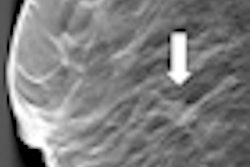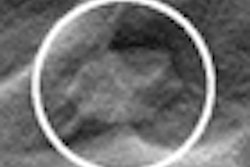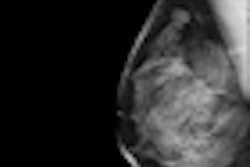Adding digital breast tomosynthesis (DBT) to digital mammography boosts accuracy in finding soft-tissue abnormalities, researchers report in the October issue of Clinical Radiology. And that can only help reduce both healthcare costs and patient anxiety.
"The accuracy of conventional mammography is limited by anatomical noise resulting from the superimposition of normal structures," wrote researchers from King's College Hospital in London. "In clinical practice, this may affect both sensitivity and specificity. ... [DBT] has the potential to improve the accuracy of mammography by enabling the reader to view x-ray images of the breast tissue as a series of thin reconstructed sections, so overcoming the problem of overlying tissues on conventional two-dimensional images."
Lead author Dr. Michael Michell and colleagues included 738 women in the study. The women had been recalled for assessment following routine screening with film-screen mammography; between January 2009 and July 2010, each underwent bilateral, two-view full-field digital mammography (FFDM) and two-view DBT.
Readers scored each lesion separately for probability of malignancy on film-screen mammography, FFDM, and then DBT. The scores were compared with the presence or absence of malignancy based on the final histopathology outcome (Clinical Radiology, October 2012, Vol. 67:10, pp. 976-981).
In all, 204 out of 759 lesions found were malignant; 147 (72%) were invasive and 57 (28%) were in situ.
Michell's team performed receiver operator characteristics (ROC) analysis to assess and compare the diagnostic accuracy of the three imaging methods, calculating the area under the curve (AUC):
- Film-screen mammography alone had an AUC of 0.7882.
- FFDM and film-screen mammography combined produced an AUC of 0.8949.
- Adding DBT boosted FFDM and film-screen mammography's AUC to 0.9671.
The difference in AUC between DBT and FFDM with film-screen mammography combined was 0.0722 (p = 0.0001), and the difference in AUC between DBT and film-screen mammography alone was 0.1789 (p = 0.0001).
FFDM vs. DBT for histology-proven malignant lesions
|
DBT allowed the readers to classify ambiguous lesions found on FFDM more accurately, the authors wrote. The technology also found six additional cancers that film-screen mammography and FFDM missed.
And increased accuracy improves healthcare, Michell and colleagues noted.
"Better visualization of normal and benign features may improve the ability of the film reader to confidently diagnose cases without malignancy and thereby reduce the recall rate, with savings in resources for the healthcare system and fewer women suffering the anxiety and inconvenience associated with recall," they wrote.



















